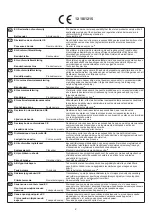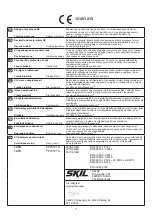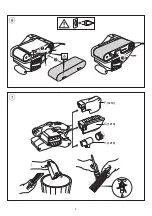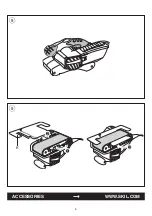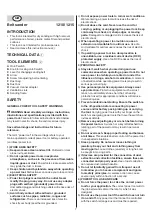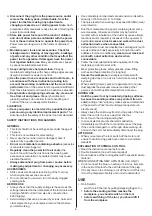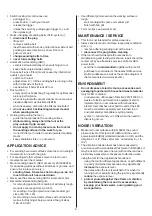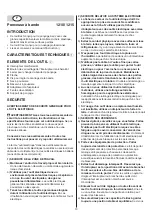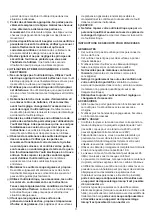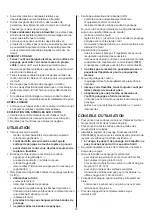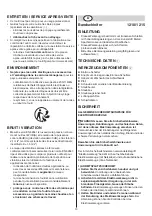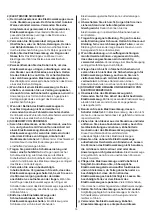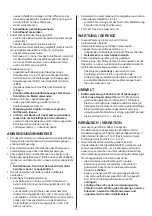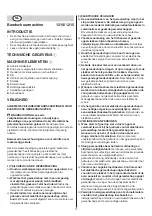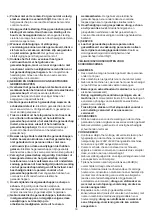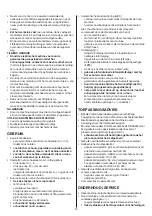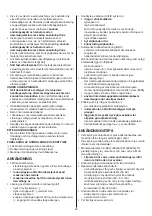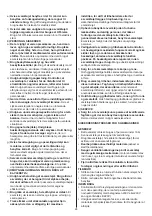
9
• Switch locking for continuous use
- pull trigger A
2
- press knob B
2
with your thumb
- release the trigger
- unlock the switch by pulling again trigger A
2
and
then releasing it
• Quick-changing of sanding belts (CLIC system)
6
! disconnect the plug
- lift lever C
- remove sanding belt
- insert new belt with arrows printed at inner side of belt
pointing in same direction as arrow D on tool
- push lever back
! change sanding belts in time
! never fold sanding belts
• Automatic belt centering (ABC)
- centers belt automatically when switching on tool
- keeps belt centered while sanding
In case belt runs off tool (mostly caused by inferior belt
quality), you should
- switch on the tool
- adjust screw E
2
till the sanding belt is running in line
with the flat side of the tool
- use new belt, if belt still runs off tool
• Dust suction
7
- empty dust box G/dust bag F regularly for optimal dust
pick-up performance
- when using tool with vacuum cleaner, mount vacuum
cleaner adaptor H as illustrated (1215)
- when necessary, also clean the filter as illustrated
! do not use dust box/dust bag/vacuum cleaner
when sanding metal
• Holding and guiding the tool
8
- guide the tool parallel to the working surface
! while working, always hold the tool at the
grey-coloured grip area(s)
! do not apply too much pressure on the tool; let
the sanding surface do the work for you
- do not tilt the tool in order to avoid unwanted sanding
marks
- keep ventilation slots J
2
uncovered
APPLICATION ADVICE
• For sanding bare wood surfaces move the tool in straight
movements in line with the grain
• For sanding all other surfaces move the tool in oval
movements over the material
• Mount sanding frame K (SKIL accessory 2610398244)
for equalizing surfaces without scratches or grooves, and
ensure it is in place securely
9
! sanding frame K becomes hot during use; do not
touch it before it has cooled down
• Never use the same sanding belt for wood and metal
• Recommended sanding belt grits:
- for removing paint and for sanding of extremely rough
wood use coarse grit sizes (40, 60)
- for sanding of rough or plain wood use medium grit
sizes (80, 100, 120)
- for smoothing of wood and surfaces with old paint as
well as for finishing of bare wood use fine grit sizes
(180, 240, 320)
• Use different grit sizes when the working surface is
rough:
- start sanding with coarse or medium grit
- finish with fine grit
• For more tips see www.skil.com
MAINTENANCE / SERVICE
• This tool is not intended for professional use
• Always keep tool and cord clean (especially ventilation
slots J
2
)
- remove adhering sanding dust with a brush
! disconnect the plug before cleaning
• If the tool should fail despite the care taken in
manufacturing and testing procedures, repair should be
carried out by an after-sales service centre for SKIL
power tools
- send the tool undismantled together with proof of
purchase to your dealer or the nearest SKIL service
station (addresses as well as the service diagram of
the tool are listed on www.skil.com)
ENVIRONMENT
• Do not dispose of electric tools, accessories and
packaging together with household waste material
(only for EU countries)
- in observance of European Directive 2012/19/EC on
waste of electric and electronic equipment and its
implementation in accordance with national law,
electric tools that have reached the end of their life
must be collected separately and returned to an
environmentally compatible recycling facility
- symbol
5
will remind you of this when the need for
disposing occurs
NOISE / VIBRATION
• Measured in accordance with EN 62841 the sound
pressure level of this tool is 87 dB(A) and the sound
power level 98 dB(A) (standard deviation: 3 dB), and the
vibration 2.1 m/s² (triax vector sum; uncertainty K = 1.5
m/s²)
• The vibration emission level has been measured in
accordance with a standardised test given in EN 62841; it
may be used to compare one tool with another and as a
preliminary assessment of exposure to vibration when
using the tool for the applications mentioned
- using the tool for different applications, or with different
or poorly maintained accessories, may significantly
increase the exposure level
- the times when the tool is switched off or when it is
running but not actually doing the job, may significantly
reduce the exposure level
! protect yourself against the effects of vibration
by maintaining the tool and its accessories,
keeping your hands warm, and organizing your
work patterns


